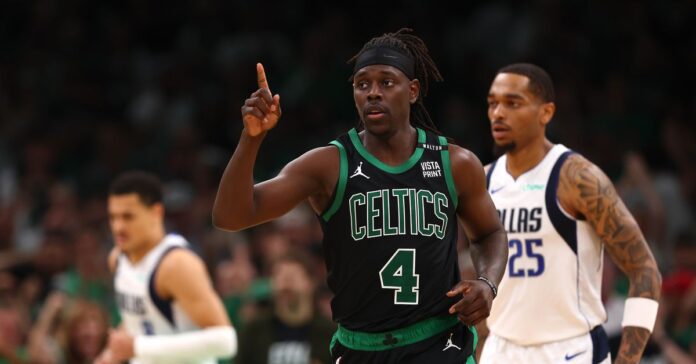The NBA Finals is full of nuance. The two teams remaining have earned their right to challenge for the Larry O’Brien trophy. This year, it’s the Boston Celtics and Dallas Mavericks who are going toe-to-toe and head coaches Joe Mazzulla and Jason Kidd are both seeking advantages to give their team an edge.
One advantage Mazzulla has been utilizing is an inverted dunker spot, which means putting a small in one of the two dunker spots rather than a big. That’s why we often see Derrick White or Jrue Holiday lurking on the baseline. And this shouldn’t be new to Celtics fans. We’ve seen the Celtics lean into this concept throughout the regular season. Now, we’re seeing all that hard work and habit-building start to pay off.
:no_upscale()/cdn.vox-cdn.com/uploads/chorus_asset/file/25486383/ezgif_6_ba353b3e78.jpg)
There are two main benefits to utilizing an inverted dunker spot.
Making a guard protect the rim
In this example, Payton Pritchard is the small in the dunker spot. His cut has taken Kyrie Irving down to the baseline, forcing him to become the low man and putting him into position to protect the rim if the Celtics can penetrate the defense.
By bringing smaller players into the paint, the Celtics are weakening Dallas’ rim protection and opening up opportunities to force collapses, where they can either create for themselves or kick the ball out to a shooter or secondary cutter.
Sometimes, the Celtics can get a similar result by having a small cut toward the dunker spot before relocating. The above clip shows Derrick White cutting toward the dunker spot before relocating to the corner. His cut puts Irving back by the baseline, allowing Jrue Holiday to bully drive into the paint and attack the rim without having a big man rotating over to impact his shot.
Here’s another example. This time, it’s White in the dunker spot. Once again, Irving has been forced into a spot where he must step up and contain a drive while trying to protect the rim. As the defense collapses on Brown to limit his drive into the paint, White is left wide open along the baseline. As such, it’s an easy pass into space with a catch-and-shoot middie for the bucket.
The most common player to be utilized in the dunker spot has been Holiday. He’s frequented that spot on the floor throughout the season. If you’ve been keeping up with my “Takeaways” articles, you will know I’ve coined him ‘Dunker Spot Jrue.’
“I’m not really sure people actually knew that but there’s a lot of time being in the dunker and trying to space the floor and have the best spacing, but I think for this team, me down there trying to make plays out of the dunker a lot of the time helps,” Holiday said during a post-practice news conference.
Below is a clip from a game against the Washington Wizards earlier in the season. Holiday is working as the inverted dunker spot guard. Watch how his relocation creates the space for Kristaps Porzingis to slip the screen and have no low man protecting the rim off the catch.
And in the following clip from Game 2, we will see Holiday force PJ Washington to zone up on defense, guarding both the dunker spot and looking to contain Tatum’s drive. As Washington commits, Holiday is wide open to finish the play off the easy pass.
Forcing the peel switch
Another way an inverted dunker spot can pressure the defense is by forcing a peel switch on the initial cut toward the rim. The switch can create confusion among the defense or generate a mismatch elsewhere on the floor.
Dallas utilizes peel switches on drives as part of their general defensive system. Forcing a pre-switch to keep a big in the paint can become problematic when guarding the perimeter on kick-outs or secondary drives/cuts.
In the opening sequence, White cuts toward the dunker spot. Daniel Gafford calls out the peel switch. Ultimately, Derrick Jones Jr. is forced to guard the corner on a close-out. His rotation produces a gap for Holiday to attack.
It’s often the little details that make or break a play, action or concept. Boston’s inverted dunker spot is bending the Mavericks’ defensive principles. It’s forcing smaller guards to protect the rim against a roster full of slashers and strong bodies. It’s also giving the Celtics a ball-handler with a high basketball IQ down low, so they can make reads on the fly and keep the offense moving when the defense has shut down the initial action.
Of course, this is just one wrinkle in a bigger playbook. However, it’s a wrinkle that has been cooking the Mavericks over the first two games. Kidd will undoubtedly want to try and solve the action before Game 3.
Otherwise, Irving and Co. could find themselves trying to stop even more rim attempts from Brown, Tatum and Holiday while Gafford or Maxi Kleber are somewhere on an island around the perimeter. Something tells me the Mavericks are going to continue to struggle, primarily because their defensive principles tell them to collapse on the drive, and that makes having a small in the dunker spot very appealing.





















